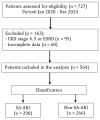Prognostic Value of Lactate/Albumin Ratio and NEWS-Lactate in Predicting Sepsis-Associated Acute Kidney Injury: A Retrospective Analysis
- PMID: 40801064
- PMCID: PMC12341009
- DOI: 10.22037/aaemj.v13i1.2723
Prognostic Value of Lactate/Albumin Ratio and NEWS-Lactate in Predicting Sepsis-Associated Acute Kidney Injury: A Retrospective Analysis
Abstract
Introduction: Sepsis-associated acute kidney injury (SA-AKI) is a frequent complication in critically ill patients and is associated with increased mortality. This study aimed to evaluate the prognostic value of the lactate/albumin ratio (LAR) and other albumin-based biomarkers in predicting SA-AKI.
Methods: A retrospective observational study was conducted on 564 patients with sepsis, divided into two groups based on the presence (n = 298) or absence (n = 266) of AKI. Clinical characteristics, laboratory parameters, and disease severity scores (SOFA, APACHE II, NEWS, NEWS-Lactate) were compared between groups. The predictive performance of each marker in detecting SA-AKI was assessed using receiver operating characteristic (ROC) curve analysis.
Results: Patients with SA-AKI had significantly higher levels of lactate (p = 0.001), procalcitonin (PCT) (p = 0.001), urea (p = 0.019), creatinine (p = 0.004), and lower albumin (p = 0.001) concentrations upon admission. The LAR demonstrated the highest discriminative performance among all tested markers, with an area under the curve (AUC) of 0.800 (95% confidence interval (CI): 0.765-0.835), sensitivity of 70.5% (95% CI: 64.9 - 75.6), and specificity of 70.3% (95% CI: 64.4 - 75.7) at a cut-off value of 0.101. NEWS-Lactate also showed good prognostic ability (AUC = 0.772, 95% CI: 0.734-0.809), sensitivity of 71.1% (95% CI: 65.6 - 76.2), and specificity of 63.2% (95% CI: 57.1 - 69.0) at a cut-off value of 7.11. Other indices, including serum creatinine/albumin ratio (sCAR), blood urea nitrogen/albumin ratio (BAR), and procalcitonin/albumin ratio (PAR), and procalcitonin (PCT) × lactate, yielded moderate AUCs. While NEWS alone showed limited predictive value (AUC = 0.508), both SOFA and APACHE II scores were significantly higher in the SA-AKI group.
Conclusion: It seems that, the LAR and NEWS-Lactate are promising biomarkers for early detection of SA-AKI and may outperform conventional severity scores and standalone laboratory parameters.
Keywords: Acute kidney injury; Biomarkers; Prognosis; Sepsis; Serum albumin.
Conflict of interest statement
The authors declare no conflict of interest.
Figures


Similar articles
-
Prognostic value of the lactate-to-albumin ratio in critically ill chronic heart failure patients with sepsis: insights from a retrospective cohort study.Front Med (Lausanne). 2025 Jul 15;12:1593524. doi: 10.3389/fmed.2025.1593524. eCollection 2025. Front Med (Lausanne). 2025. PMID: 40735448 Free PMC article.
-
[Impact of mean perfusion pressure on the risk of sepsis-associated acute kidney injury].Zhonghua Wei Zhong Bing Ji Jiu Yi Xue. 2025 Apr;37(4):367-373. doi: 10.3760/cma.j.cn121430-20240823-00722. Zhonghua Wei Zhong Bing Ji Jiu Yi Xue. 2025. PMID: 40814710 Chinese.
-
Prognostic Value of Blood Urea Nitrogen to Albumin Ratio in Elderly Critically Ill Patients with Acute Kidney Injury: A Retrospective Study.Medicina (Kaunas). 2025 Jul 8;61(7):1233. doi: 10.3390/medicina61071233. Medicina (Kaunas). 2025. PMID: 40731862 Free PMC article.
-
Accuracy of routine laboratory tests to predict mortality and deterioration to severe or critical COVID-19 in people with SARS-CoV-2.Cochrane Database Syst Rev. 2024 Aug 6;8(8):CD015050. doi: 10.1002/14651858.CD015050.pub2. Cochrane Database Syst Rev. 2024. PMID: 39105481 Free PMC article.
-
Clinical symptoms, signs and tests for identification of impending and current water-loss dehydration in older people.Cochrane Database Syst Rev. 2015 Apr 30;2015(4):CD009647. doi: 10.1002/14651858.CD009647.pub2. Cochrane Database Syst Rev. 2015. PMID: 25924806 Free PMC article.
References
-
- Rahmatinejad Z, Hoseini B, Rahmatinejad F, Abu-Hanna A, Bergquist R, Pourmand A, et al. Internal Validation of the Predictive Performance of Models Based on Three ED and ICU Scoring Systems to Predict Inhospital Mortality for Intensive Care Patients Referred from the Emergency Department. Biomed Res Int. 2022;2022:3964063. - PMC - PubMed
Publication types
LinkOut - more resources
Full Text Sources
Miscellaneous
